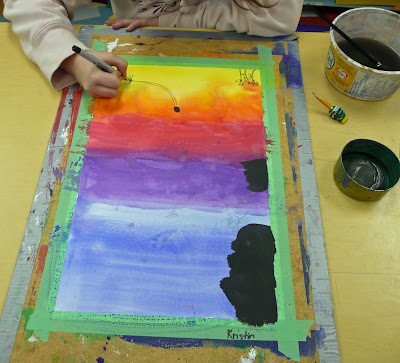Now this owl design has been around for decades, I did a similar one when I was in school, so I'm not claiming ownership. If you want to check out some other clay owl projects you can check out these:
- 4 Crazy Kings version
- Mr's Picasso's Art Room version
- Jeryl Hollingsworth La France Elementary at Incredible Art Dept. version
If you don't have access to a kiln you can check out my other great Owl Projects:
Owl Assemblage
Pastel Resist Owl
Mixed Media Owls
Pom Pom Owls
Mini Macramed Owl Necklaces
MATERIALS REQUIRED:
- low fire clay
- penny nail
- rolling pin
- piece of canvas to work on, can also use a paper towel
- circular items to create imprints
- electric kiln
- low fire glaze
- hemp or leather cording for hanger
- water
Roll out a slab about 1/2 an inch thick and cut out a circle using your penny nail. We used a chinette dinner plate as a template. Using a little water, (I get the kids to dip their finger into a little cup), smooth out and rough edges on the circle. If you leave those little crumbs and they make thru the bisque fire they become very sharp.
Using your circular items create feather detail on the lower half of the circle. We got some great results with one of those little wooden ice cream spoons, like from a dixie cup.
You can see the spoon and the results on this student's owl.
Fold over both sides of your circle to create the wings. Squish it down into place a bit.
Fold over the top of the circle to form the head.
Using your circular items create imprints to form the eyes.
From the leftover clay cut out a triangular beak. Scratch both the back of the beak and where you are going to place it, add a little water and then stick into place.
Add some detail on the wings. Make sure to take that penny nail and make a hole thru the top all the way through for hanging.
Some student work in process:
Leave to dry out. I waited 2 weeks as we were pretty damp here in Calgary the last while.
Bisque fire in the kiln. For me this is cone 4 on our SKUTT.
Glaze with low fire glaze, we use Mayco Stroke and Coat. I buy my glazes at Ceramics Canada. I ask the kids to put on at least 2 -3 coats.
Let dry and then glaze fire. I use cone 6 on the SKUTT. (it depends on the clay and kiln what you may use)
Add a loop of hemp or leather cording thru the hole for a hanger and that's it.
Here is our parliament of Owls. Great job Grade 4!!
Don't forget you have until 11:59 pm on Thursday to enter for the Book Giveaway.
Today is our first official day of Summer Vacation!
Stayed tuned for lots of new projects over summer as I will have some time to get organized.
Also I am co teaching a workshop in Fernie, B.C for 8-10 yr. olds "Writing and the Visual Arts". If you are in the area and interested check out the website for registration.
As well I will be in Lloydminister at the end of August presenting an Art Education workshop for all you wonderful teachers in that neck of the woods.













































